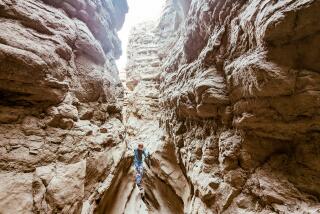Life Abounds in the Largest Active Sand Dune This Side of the Sahara : Ecology: Wyoming’s Killpecker Sand Dunes are a mile above sea level and 100 miles long. Environmentalists hope to keep some of the area off limits to dune buggies and other human intrusions.
- Share via
ROCK SPRINGS, Wyo. — The world’s second-largest active sand dune is in an unexpected place--more than a mile above sea level in southwestern Wyoming.
The Killpecker Sand Dunes teem with life, from the graceful desert elk to the resourceful Jerusalem crickets and the spadefoot toads that shovel out holes with their hind feet and back themselves in during the day.
The sands themselves seem to writhe in a slow-motion dance with the mighty, constant winds. Such winds first began scraping the earth to create the dunes 20,000 years ago near the end of the last glacial age.
Scientists and federal environmentalists keen to preserve at least part of the 170 square miles of dunes hope to get Congress to designate some of it worthy of protection from the one creature that doesn’t live here naturally: humans. They drive in to hunt and ride in on dune buggies to play.
From the air, the Killpecker resembles a snake trailing 100 miles nearly straight west and east, three to 13 miles wide in places and pockmarked by water holes and scarred by the crude roads the vehicles trace.
The eastern end starts about 150 miles west of Cheyenne. The western end is 200 miles northeast of Salt Lake City. Composed of roughly one cubic mile of sand, the Killpecker is second only to the active dunes found in the Sahara in North Africa.
Animal tracks crisscross the Killpecker’s desert waves. But it’s the tracks humans make that bother federal wildlife specialist Andy Tenney, who worries about harm to the fragile desert ecosystem.
“The unstable dunes are sensitive,” Tenney said. “You don’t want to break down the dune community by having people drive on them.”
To that end, Tenney and others at the Rock Springs District of the U.S. Bureau of Land Management are asking Congress to designate federal wilderness protection for the western and most unstable section of the dunes 30 miles north of Rock Springs where shifting sands soar as high as 150 feet.
A study was completed in 1991 and the federal land management agency is now awaiting a congressional decision on the proposed Wyoming Public Lands Wilderness Act, which includes protection for the dunes. A grant of federal protection would provide money to enforce preservation of the dunes against unwanted traffic and oil and mineral developers.
Federal officials say they expect the bill to pass.
For the time being, signs intended to ward off intruders are posted every 100 feet along outlying roads. They’re evidently ignored, judging by the signs shot down and flattened. “Every hunting season, these roads that are just about to recover, people drive on them,” Tenney said.
The penalty is a $100 fine--if violators can be caught. “To me, it’s just like a slap on the wrist,” said Tenney, nicknamed “Sandman” by colleagues because he dotes on the remote stretch he visits once or twice a week.
Many others have found much pleasure in this place.
Hikers, wildlife spectators, campers, nature study groups and scientists know the area. It’s also one of the best spots in the country to hunt antelope.
Dune buggy riders may use a 10,500-acre patch just east of the area under study. They find the Wyoming dunes ideal because they are unusually long and flat.
“Everybody raves about it. You hang with the buggy crowd and you hear about these places and you have to search them out,” said Mark Russo, a recent visitor from Lafayette, Colo.
Buggy riders also need to study the dunes.
They must watch for steep slopes that hide ponds below. Part of the buggy area is an active gas field, so it’s necessary to keep eyes out for pipelines that poke through the sand.
Doug Varilek doesn’t mind.
“As long as it’s sand, we love it,” said Varilek of Thornton, Colo., as he roared straight over a dune in his remodeled Volkswagen bug. “You’re like a little kid in a sandbox.”
The sandbox has been growing, thanks to nearly a decade of drought.
“We’ve got a sand dune that in the 20 years I’ve been here it’s grown a couple times and advanced across the road one year and died back and stabilized,” said Jim Dunder, a biologist with the Bureau of Land Management. Because of the drought, he said, the dune is now around the middle of the road.
It’s not always the most comfortable playground, though.
“You better run around there in the morning because by noon the wind is sandblasting,” Dunder said.
Water also comes with this wild terrain. In winter, blowing sand covers patches of snow and ice that accumulate on the sheltered side of the dunes. These so-called iceboxes in the sand melt in summer to form freshwater ponds.
Sixty to 90 ponds dot the sandscape, some 12 feet deep. They host salamanders and freshwater shrimp and white, eyeless junebugs with big stingers. “You don’t want to run around barefoot,” Dunder advised.
The sand holds many other treasures.
As Tenney walked along the dunes recently showing visitors around, he pointed out more signs of life, the black pellet-like elk droppings, the clumps of silver buffalo berry, the grasses and sagebrush.
The country’s only known desert elk herd also inhabits the dunes. The herd died off before the turn of the century but elk were transplanted back to the area in the 1940s and 1950s. Numbering about 1,000 in the mid-’70s, the elk population has dipped under hunting pressure to between 400 and 500.
The desert elk prove a strong attraction to companies filming wildlife. The majesty of elk surrounded by a desert backdrop and striking features like the Boar’s Tusk, a 400-foot volcanic monolith, have entertained more than one moviegoer.
“It’d be hard to duplicate our sand dunes anywhere else because of the unique plant and animal species that occupy them,” Dunder said. “It’s probably not very well known . . . but they are unique.”
More to Read
Sign up for Essential California
The most important California stories and recommendations in your inbox every morning.
You may occasionally receive promotional content from the Los Angeles Times.













